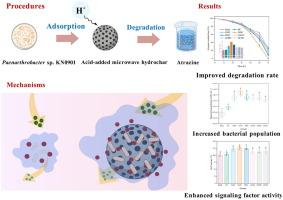Constructing hybrid microorganism-material systems to improve pollutant bioremediation: Investigating the improved bioactivity and quorum sensing of a functional strain with acid-added microwave hydrochar
IF 13.3
1区 工程技术
Q1 ENGINEERING, CHEMICAL
引用次数: 0
Abstract
The ecology is seriously endangered by atrazine residue, which is generated and accumulated by agricultural practices. The atrazine-degrading bacterium Paenarthrobacter sp. KN0901 and acid-added microwave hydrochar are used in this work to construct hybrid microorganism-material systems that effectively remove atrazine from the environment. The baseline atrazine degradation rate increased by 25.5 % when H2SO4-added microwave hydrochar (ISHC) was added, after 72 h of incubation at 15 °C. With the addition of acid-added microwave hydrochar, the number and autoinducer-2 activity of strain KN0901 increased significantly, suggesting the enhanced quorum sensing compared to the free bacterial cells. The biochemical reaction levels in strain KN0901 were regulated as a result of enhanced quorum sensing. The expression levels of genes associated with atrazine biodegradation in strain KN0901 were significantly elevated following the addition of AMHC, leading to an increased production of hydrolases involved in atrazine degradation. Furthermore, the biofilm formation process was improved with AMHC treatment, facilitating a greater exchange of substances between the interior and exterior of the bacterial cells. This enhancement allows for more efficient uptake of atrazine by strain KN0901, thereby promoting the degradation. The findings indicate that acid-added microwave hydrochars improved atrazine degradation by enhancing the quorum sensing of strain KN0901. The atrazine degradation rate in this system increased under different conditions, including changes in the pH, temperature, salt concentration, and heavy metal concentrations. This study presents a novel methodology for the development and application of bioremediation techniques aimed at addressing atrazine contamination in various environmental conditions.

求助全文
约1分钟内获得全文
求助全文
来源期刊

Chemical Engineering Journal
工程技术-工程:化工
CiteScore
21.70
自引率
9.30%
发文量
6781
审稿时长
2.4 months
期刊介绍:
The Chemical Engineering Journal is an international research journal that invites contributions of original and novel fundamental research. It aims to provide an international platform for presenting original fundamental research, interpretative reviews, and discussions on new developments in chemical engineering. The journal welcomes papers that describe novel theory and its practical application, as well as those that demonstrate the transfer of techniques from other disciplines. It also welcomes reports on carefully conducted experimental work that is soundly interpreted. The main focus of the journal is on original and rigorous research results that have broad significance. The Catalysis section within the Chemical Engineering Journal focuses specifically on Experimental and Theoretical studies in the fields of heterogeneous catalysis, molecular catalysis, and biocatalysis. These studies have industrial impact on various sectors such as chemicals, energy, materials, foods, healthcare, and environmental protection.
 求助内容:
求助内容: 应助结果提醒方式:
应助结果提醒方式:


